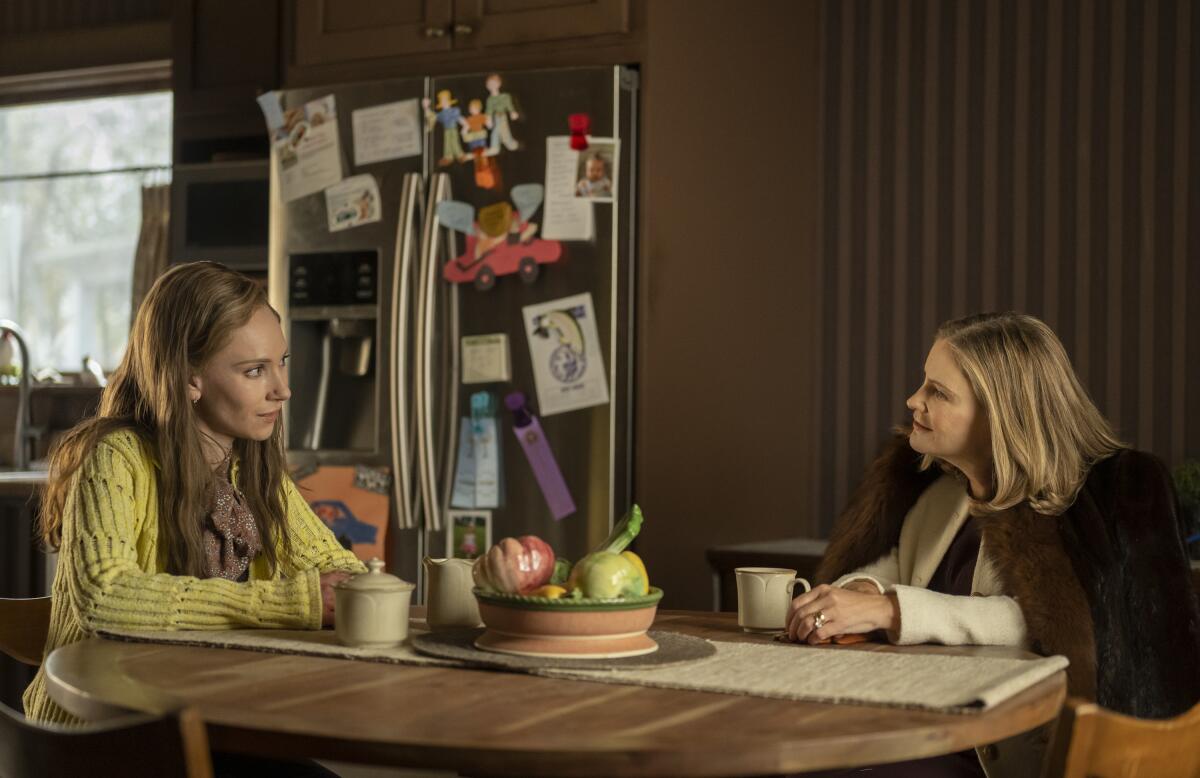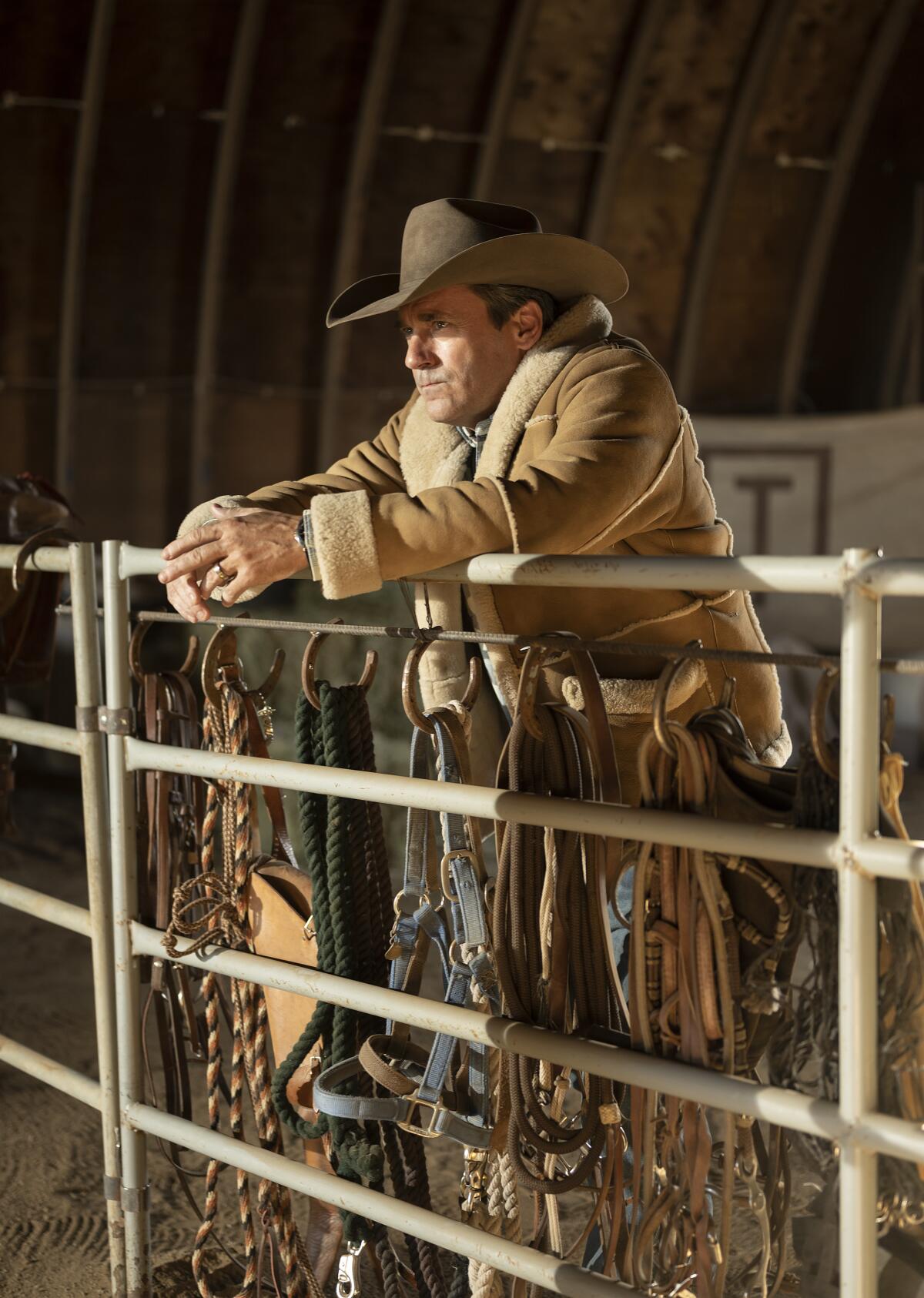Strong women, including Juno Temple, take the lead as ‘Fargo’ returns to its roots

- Share via
The new season of “Fargo,” Noah Hawley’s fifth variation on a theme by the Coen brothers, arrives Tuesday on FX. (It streams Wednesday on Hulu.)
The anthological series, which I never quite expect to return and am surprisingly excited when it does — it’s music I like, but it takes its time between seasons and fades from memory — takes certain geographical, thematic and tonal elements from the Coens’ 1996 film. It will be bloody; like a Dickens novel, it will bring together various strata of society. There is usually an honest officer, or officers, of the law; someone in over their head; and a hard-to-stop, possibly crazy hired killer. In most seasons there is snow. They share something of the architecture of the Western, which the current season makes more than usually explicit with a complement of cowboy hats, horses, cattle and prairie views. And every year has been a masterpiece of inventive casting.
The fourth season, which aired in 2020 and starred Chris Rock and Jason Schwartzman, was something of a departure, a big-canvas story set in the early 1950s in which Black and Sardinian mobs vied for control of Kansas, Mo., farther from Minnesota and North Dakota, the series’ spiritual and often actual center. It was an even bloodier season than usual, leaving its main and many minor characters dead; yet it still found a way, in “Fargo” fashion, to end on an upbeat note.
The new season is something of a return to its roots. We are back in Minnesota (and North Dakota), in cold weather, and the nearly present day, at a school fall festival planning committee meeting where Dorothy Lyon (Juno Temple) is attempting to keep her head when all about her, ordinary citizens are whomping the stuffing out of one another. (“I’ve Seen All Good People” by Yes blasts on the soundtrack, very effectively.) As she tries to flee the scene with her daughter, Scotty (Sienna King), she winds up tasing a math teacher and a couple of policeman, which lands her in jail, introduces us to Deputy Indira Olmstead (Richa Moorjani), the latest of “Fargo’s” dogged female cops, and sets off the alarm that will bring trouble calling.

Dorothy is married to Wayne (David Rysdahl), a likable lug who has a car dealership, a trust fund he doesn’t touch and an imposing mother, Lorraine (Jennifer Jason Leigh), who runs “a Nasdaq-listed multibillion corporation” and has “six governors on speed dial and my own personal liaison at the Federal Trade Commission.” Her company, Redemption Services — the religious overtone seems intentional, though it may be only an overtone — buys consumer debt. (And debt, of different sorts, is a recurring theme through the series, including a yet to be explained, if ever, brief flashback to medieval Wales.)
Lorraine does not much care for Dorothy, whom she dismisses as lower class and possibly after her money. But that there is more to her than chirpy housewifery soon becomes apparent, as Dorothy puts up a defense against a pair of masked kidnappers — Sam Spruell as Ole Munch is this season’s designated oddball killer. Before long, it leads to a beautifully staged, very suspenseful fight scene — the sort of scene that would form the climax of most movies — set in a lonely gas station convenience store that brings Lamorne Morris into the story as North Dakota Deputy Witt Farr.
Incidentally or perhaps inspirationally, Morris’ character on “New Girl,” Winston Bishop, finished that series in a police uniform; similarly the character played here by Jon Hamm, Roy Tillman, the sheriff of a very rural North Dakota county, who quotes Bible verse on the way to doing whatever he wants to, seems related to the cult leader he played in “The Unbreakable Kimmy Schmidt.” (Joe Keery plays his hapless son and deputy, Gator.) We glimpse him only briefly in the opening episode, in a single shot, sitting sternly at the head of a dinner table, but it tells us that whatever is mysterious about Dorothy has something to do with him.
The series always has at least a little to say about Who We Are, or Who We Were, or How Who We Were still informs Who We Are. The final episode of last season, which looked at racism through a framework of organized crime, was titled “Storia Americana”; Ronald Reagan, played by Bruce Campbell, was an actual character in the second season, set in 1979. This year, the show is set in 2019 — the closest of any season to the time it’s being released in — and you would have to actually not watch the series to miss its points, about weak and toxic men, sexism, misogyny, religion as a tool of oppression, and far-right paranoia.
Characters make references to “a nation under siege,” welfare mothers, Mexican rapists and “the whole multicultural panoply.” Lorraine and her family pose for a Christmas card holding automatic weapons, obviously based on a similar one by 2021 by Rep. Thomas Massie of Kentucky; these characters don’t necessarily have much to do with guns — Lorraine says it’s about showing strength and projecting their family values — but it announces that the present is very much in the series’ sight.
(Even the weird killer gets a speech that seems to speak to a certain American malaise: “Now everywhere you look, you see kings. Everything they want they call their own and if they cannot have it they say that they are not free.” You do see that around.)

For all its deeper thoughts, “Fargo” is a cartoon at heart, with exaggerated characters in extreme situations, and a willingness — as with Season 3’s flying saucer — to get weird. (There may be a supernatural element in the current season, but it’s hard to tell.) It plays with film conventions, refers back, as appropriate, to earlier visual styles, and creates a world that, while always exquisitely detailed, is not exactly realistic — despite the bogus disclaimer, carried over from the movie, that everything really happened. And yet it feels emotionally true. When talented actors play caricatures straight and directors film them without winking, you can get something productive, wildly comic but recognizably human; it allows for broad gestures that don’t negate the emotional truth, and subtle ones in unexpected places.
As Lorraine, Leigh delivers her lines something like Mae West filtered through Bette Davis, with a bit of the catlike indolence of her Dorothy Parker in Alan Rudolph’s “Mrs. Parker and the Vicious Circle”; but the effect here is of a person who knows she doesn’t need to move quickly or speak loudly to demonstrate power. She speaks like a refugee from a 1940s potboiler — “Something’s fishy here. I smell a rat” and “Listen, Slick, nothing would make me happier than to put that girl in a box marked return to sender” — but with a patina of acquired elegance.
Temple, best known here for “Ted Lasso,” is terrific. As the show’s most imperiled person, and also its action hero, she uses her physical slightness to dramatic advantage; the “Fargo” accent, an inheritance from the film possibly more than from the actual state of Minnesota, is comical but also serves her character as a kind of mask. (Not every character employs it.) Hamm’s sheriff is much more nuanced than he deserves to be; Dave Foley, who plays Lorraine’s right-hand and lawyer, Danish Graves, sporting an eye patch without explanation, like the Hathaway Shirt man (Google it), is low-key, as in “NewsRradio,” and essential to the arrangement. As a Morris fan, I hope (and expect) to see more of him as things develop. And Moorjani carries on admirably the spirit of Frances McDormand, Allison Tolman and Carrie Coon, as the franchise’s Strong Woman With a Badge. (Though it’s a season of strong women.)
Where will this fifth land in the final ranking of “Fargo” seasons? With only six of 10 episodes out for review, it’s too soon to say, if it’s even possible to say, or worth trying. Every season sings in its own key, builds up its own nest of details. Three-fifths of the way in, the story feels comparatively conventional, notwithstanding that medieval flashback. But with four hours left to go — two whole “Fargo” movies — there are certainly surprises ahead, twists around corners hidden behind corners. Things will probably get crazy, and I’m eager to see it.
More to Read
The complete guide to home viewing
Get Screen Gab for everything about the TV shows and streaming movies everyone’s talking about.
You may occasionally receive promotional content from the Los Angeles Times.







